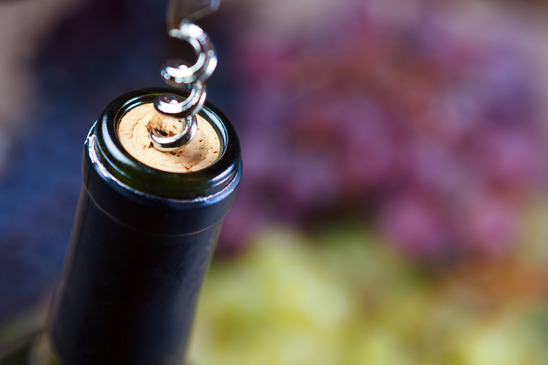
When it comes to replacing your favorite well-worn bottle opener, adding a new corkscrew to your collection, or shopping for a fellow wine lover, you have a few questions to consider. Is an opener worth its price? How easy is it to use? It it suitable for all the bottles in your collection? Learn about the pros and cons of a few of the most popular wine openers on the market, from the simple to the fully loaded.
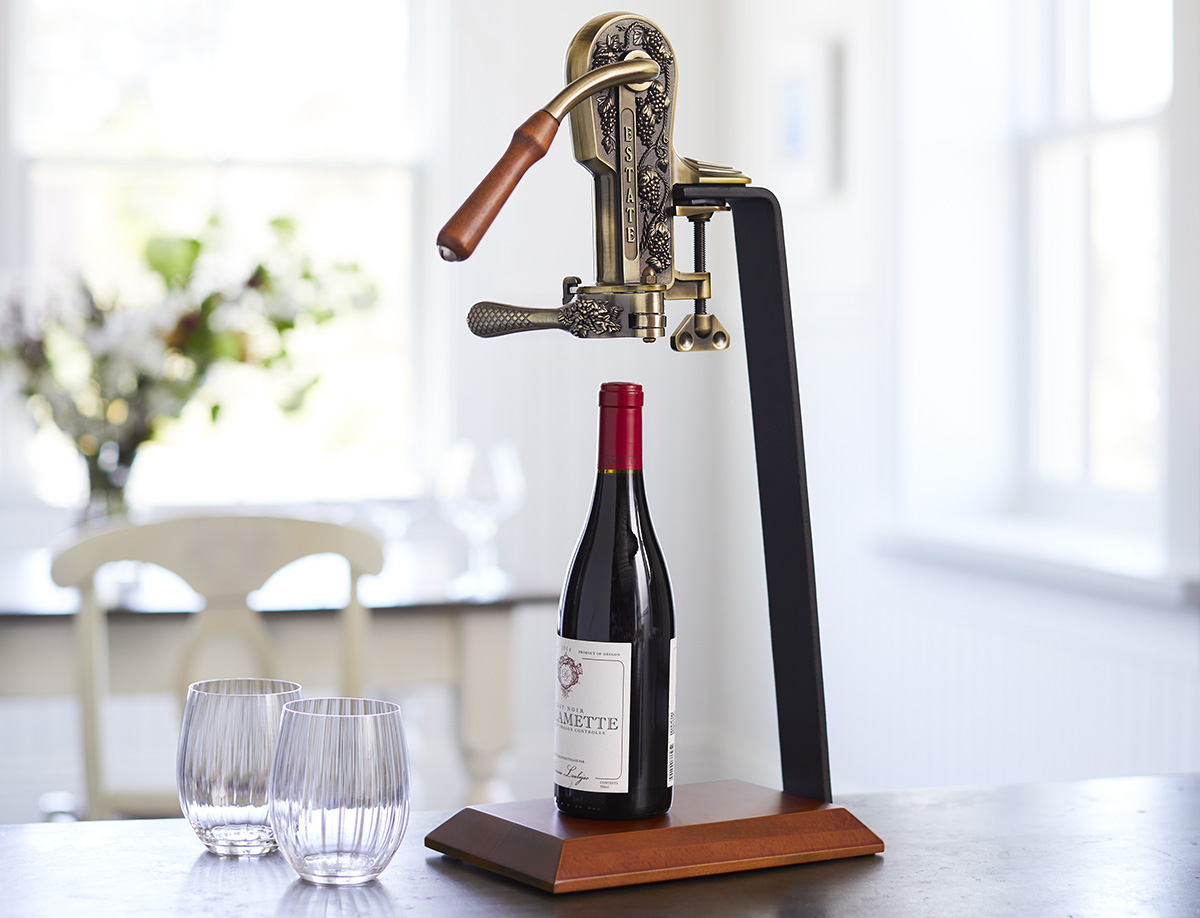
Lever Corkscrews
The lever style, popularized by The Rabbit, is the most popular model on the market. It clamps easily around the neck of the bottle. With a smooth pull and raising of a lever, this opener inserts a spiral and pulls the cork right out. Its ease of use could be a particular asset for older or less-agile wine lovers as it offers extra stability, power and control.
This style of corkscrew makes opening a bottle look effortless. If you’re throwing a party and want to dazzle your guests while opening several bottles in a short amount of time, this is the answer.
Pros:
- Requires little effort to open a bottle.
- Most brands offer replacement spirals as they dull with age.
- These corkscrews are aesthetically pleasing, so you can openly display them on the bar.
Cons:
- Due to its size, this style isn’t easily stored and takes up a lot of space.
- The forcefulness of the lever style has its downsides. It sometimes inserts with such force that it can push a cork partway into the bottle. Usually the cork still extracts completely, but it can create a suction and spray wine as it does so.
- The force of the lever style is not appropriate for opening aged gems in your cellar, as it can easily destroy an older or more delicate cork.
Best for: Those who like sleek design and love to entertain, less physically agile users who need extra stability, control and leverage. For an easy-to-use and attractive everyday opener, it’s a worthy addition to your collection.
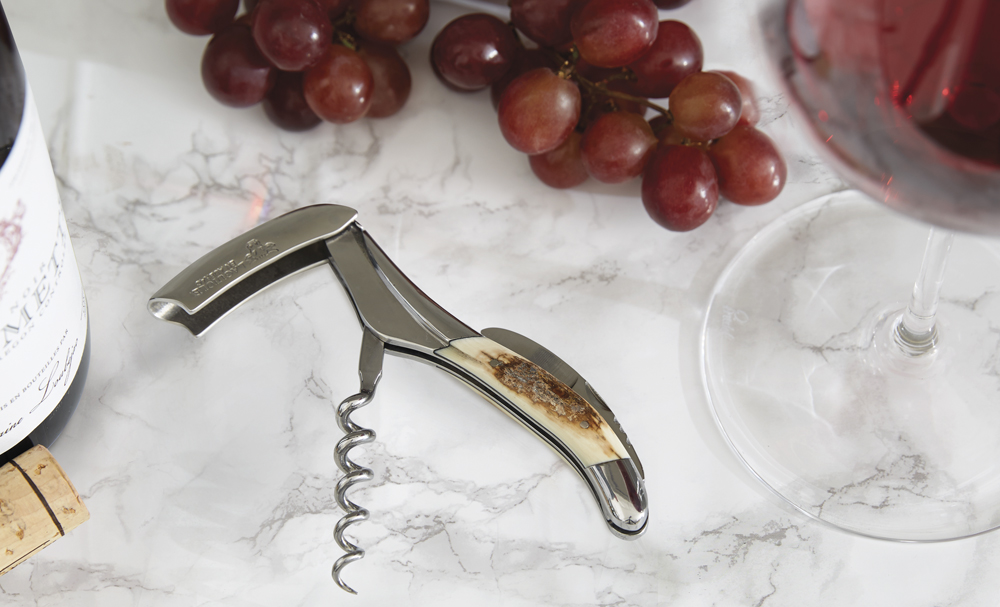
Waiter’s Corkscrew
This is a the simplest, most universally effective opener on the market. It is likely your go-to corkscrew, and for good reason! The double-hinged version, in particular, is a favorite among wine connoisseurs and professionals. Often accompanied by a built-in foil cutter, the waiter’s style opener is compact, low-tech and easy for a savvy drinker to use.
We recommend Laguiole En Aubrac corkscrews, which are made in France by master craftsmen. They are handcrafted with extra-long, five-turn stainless steel grooved spirals and serrated blade foil cutters, and come with lifetime warranty against any manufacturing defect.
Pros:
- This style works well for any type of cork: composite, natural or synthetic.
- Because it offers so much user control regarding the force, speed and angle of insertion and extraction, this corkscrew is one of the better options for opening your prized cellar items. Even the best sommeliers sometimes break a dry or aged cork, but with the Laguiole, it is usually salvageable with a light touch.
- This compact corkscrew can slip easily into a briefcase, purse or picnic basket for those unexpected or on-the-go pours.
Cons:
- The waiters’ style corkscrew might be more difficult for older or less agile consumers to maneuver.
If you want only one opener in your collection, this is the most useful and versatile opener on the market. Every wine drinker should have at least one! But beware, not all are created equal, there are many imitation Laguiole corkscrews on the market.
Best for: Connoisseurs, collectors and everyday users who can put their weight into opening a bottle. The next time you’re looking for a personal, thoughtful gift, a Laguiole corkscrew fits the bill.
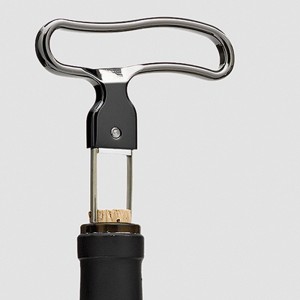 The Ah-So or Butlers Friend style corkscrew
The Ah-So or Butlers Friend style corkscrew
The Butlers Friend style opener is also known as the “Ah-So.” As in, “Ah… So that’s how you use it!”
Its simple, two-pronged style is best used on older, dry corks where a regular corkscrew would cause too much crumbling. The prongs are slipped in between the cork and neck of the bottle, gently wiggled and twisted, and the cork can be pulled up completely intact. While this openers requires some practice and skill to use, it’s the perfect low-tech, yet effective solution for savvy collectors who struggle with crumbling corks.
The Ah-So requires enough special skill to prevent it from being your go-to everyday opener. However, it is certainly worth owning, as it can be used for aged bottles in your collection. With proper technique, it extracts a dry cork with more care than any other corkscrews on the market.
Pros:
- Inexpensive
- Compact
- Won’t damage dry, aged corks
Cons:
- Requires upper body strength and stability
- Not the most versatile opener as it does not work well on slippery synthetic corks
- Requires some skill to use
Best for: Collectors who have many aged wines whose corks need extra care.
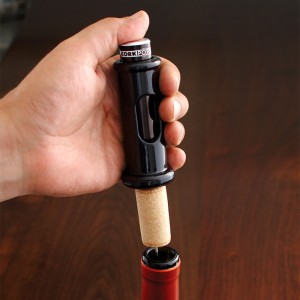 Cork Pops
Cork Pops
The Cork Pops opener is a unique and effective cork extractor that also has a significant “wow factor.” It forces carbon dioxide gas into the bottle through a needle inserted into the cork. The gas enters with such high pressure that it pops the cork right out of the bottle! Because it does not have a spiral, it works especially well for fragile corks. This style will open almost any bottle with ease and is an impressive way to entertain guests.
The Cork Pops is a fun, versatile and easy-to-use opener that rounds out any collection. It’s impressive design makes it a fun addition to your cellar.
Pros:
- Easy to use
- Works fast
- Good for aged corks
- Great for entertaining
Cons:
- Additional long-term costs due to replacement cartridges
- Doesn’t work well on synthetic or particularly long corks
Best for: Those who love to entertain or who want an effortless wine opening experience.
Do you have a favorite wine opener? Let us know in the comments.
About the author: Rebecca Cox is a Chicago-based actress, wine lover and wine shop-girl. Check out her blog Chicago Uncorked to follow her thoughts on wine tasting, enology, viticulture and wine in the Windy City.
The “Ah-So” (which I call the female corkscrew) is the only one I can use. I find that twisting it while pulling helps get the cork out. Glad to see that they’re available again; mine disappeared years ago and I couldn’t find a replacement.
– Beverly Feldt
All cork screws are not created equal. The diameter and the pitch of the screw itself is important as to not damage stubborn corks. the larger the diameter and the greater the pitch, the less likely the cork will be damaged.
– Greg
I recently purchased a most handsome Laguiole en Aubrac corkscrew. Alas, it has no notch on its lever, much like what you have pictured on this page. It’s not easy to use. I can not readily get the lever to rest on the lip of the bottle. Maybe I lack the knack, but my far less expensive Rialto, while not as elegant and without a quite as heavy helical screw, is far easier to use – as is the Coutale recently given to me by a negociant in Saint Emilion.
– Arlen
I have a Laguiole en Aubrac corkscrew. After only a few uses the screw has bent to an angle such that is protrudes substantially and dangerously from the body of the corkscrew. This Laguiole corkscrew is my second one — the same bend in the screw happened to the first. I will not purchase another one.
– Joe Danks
Hi Joe,
If you purchased a Laguiole from IWA, please send a note to support@swawine.com with photos of the problem and any original purchase information you retained, so that we can help. If your Laguiole came from a different company, the lifetime guarantee should still be in effect, and you can contact Laguiole en Aubrac directly for assistance.
I use all of the above, except the CO2 style. Additionally, I also use a ScrewPull.
– David
Magnum and larger format bottles create their set of challenges. What is the best option for removing corks from larger format bottles?
– Ron Samuelson
Hi Ron,
Generally lever corkscrews are a good choice for large format bottles, since they have better leverage than traditional waiters style corkscrews. We have a counter mounting Estate series that clamps onto the bottle and uses a strong, swinging motion to remove the cork. https://www.iwawine.com/bronze-estate-opener
– IWA
My experience with Laguiole was that due to the price & reputation, I would be able to use it for years. Wrong, after 3-4 years the screw broke. No way to get a new one. There are some great copies of the Laguiole for $30+, save your money for one of those.
– Joe Dobbs
I had a related problem with a Laguiole cork screw. After a number of uses (less than 50), the cork screw bent at an odd angle, making it difficult to use.
– Joe Danks
There are many Laguiole brands in the market, some are knockoffs and some are “authentic” with a lifetime guarantee on their products. All of the Laguiole products sold by IWA are 100% authentic. If you purchased your Laguiole corkscrew from us, whether you purchased it 3 years ago or 30 years ago, we’ll coordinate getting your broken item to the manufacturer for repair or replacement.
– IWA
I’ve used them all. I pushed too many corks into the bottle using the Ah-So. I don’t use that one anymore. I’ve used the Waiters cork screw, but have to have several on hand as the spirals have bent and become misaligned. I have used the Rabbit often, but find even those wear out so they have to be replaced. So far I have not had any issues with the Cork Pops style. I love the Corvin if I am only planning to drink a single glass or two from an aged wine. I find it works very well also. Of course, you will need additional needles and gas cartridges on hand. I have a question, if anyone can provide information. All my wines are properly cellared, but I often find that with aged wines, the cork oftentimes breaks off and half remains in the bottle. Does anyone have a good way to remove the remaining cork. I have tried everything and usually wind up pushing the remainder into the bottle.
– Ron Samuelson
If you have bits of cork left in a bottle, you can use a funnel (with fine mesh filter) to pour it into a wine decanter. This will filter out any cork pieces and will likely open up the wine before you enjoy it.
I have a rule. Any wine over 10 years of age gets it’s cork removed by an ah-so. With care, it never fails me. I have had too many broken corks to make me a believer in the ah-so for older wines. Good luck!
– Chuck
When I was younger, I waited tables for years and sold a lot of quality wine. It was essential to become proficient at opening and pouring wine. I still own my original flat waiter wine opener. Somewhere along the line I acquired what I just discovered is called a “cellar-type” wine opener. It is astoundingly ingenuous and simple to use.. and far cooler than the winged corkscrew.. If you are unfamiliar with the Cellar-type, give it a google and check it out. I particularly like it for tight white wine corks.
– J. Hamilton